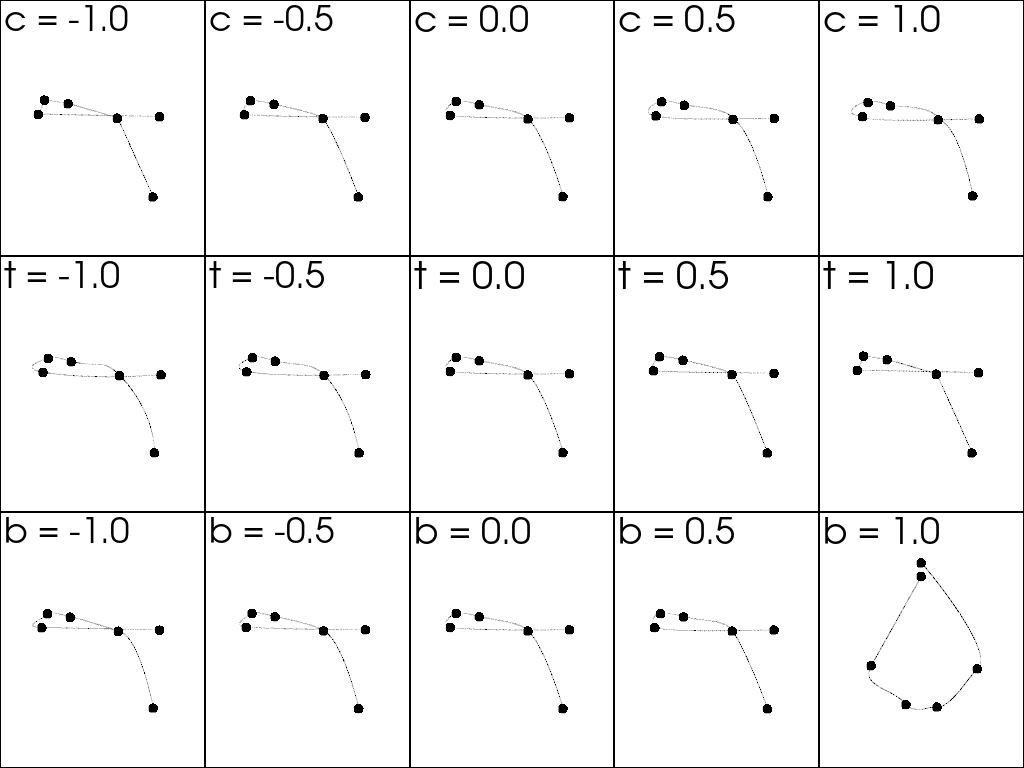Note
Go to the end to download the full example code.
Create a Kochanek Spline#
Create a Kochanek spline/polyline from a numpy array of XYZ vertices.
Uses pyvista.KochanekSpline().
import numpy as np
import pyvista as pv
Create a dataset to plot
def make_points():
"""Make XYZ points."""
theta = np.linspace(-4 * np.pi, 4 * np.pi, 6)
z = np.linspace(-2, 2, 6)
r = z**2 + 1
x = r * np.sin(theta)
y = r * np.cos(theta)
return np.column_stack((x, y, z))
points = make_points()
points[0:5, :]
array([[ 2.44929360e-15, 5.00000000e+00, -2.00000000e+00],
[-2.32057790e+00, 7.54001466e-01, -1.20000000e+00],
[-6.81830893e-01, -9.38459713e-01, -4.00000000e-01],
[ 6.81830893e-01, -9.38459713e-01, 4.00000000e-01],
[ 2.32057790e+00, 7.54001466e-01, 1.20000000e+00]])
Interpolate those points onto a parametric Kochanek spline
# Create Kochanek spline with 6 interpolation points
p = pv.Plotter(shape=(3, 5))
c = [-1.0, -0.5, 0.0, 0.5, 1.0]
for i in range(5):
kochanek_spline = pv.KochanekSpline(points, continuity=[c[i], c[i], c[i]], n_points=1000)
p.subplot(0, i)
p.add_text('c = ' + str(c[i]))
p.add_mesh(kochanek_spline, color='k', point_size=10)
p.add_mesh(
pv.PolyData(points),
color='k',
point_size=10,
render_points_as_spheres=True,
)
t = [-1.0, -0.5, 0.0, 0.5, 1.0]
for i in range(5):
kochanek_spline = pv.KochanekSpline(points, tension=[t[i], t[i], t[i]], n_points=1000)
p.subplot(1, i)
p.add_text('t = ' + str(t[i]))
p.add_mesh(kochanek_spline, color='k')
p.add_mesh(
pv.PolyData(points),
color='k',
point_size=10,
render_points_as_spheres=True,
)
b = [-1.0, -0.5, 0.0, 0.5, 1.0]
for i in range(5):
kochanek_spline = pv.KochanekSpline(points, bias=[b[i], b[i], b[i]], n_points=1000)
p.subplot(2, i)
p.add_text('b = ' + str(b[i]))
p.add_mesh(kochanek_spline, color='k')
p.add_mesh(
pv.PolyData(points),
color='k',
point_size=10,
render_points_as_spheres=True,
)
p.show(cpos='xy')

Total running time of the script: (0 minutes 0.768 seconds)